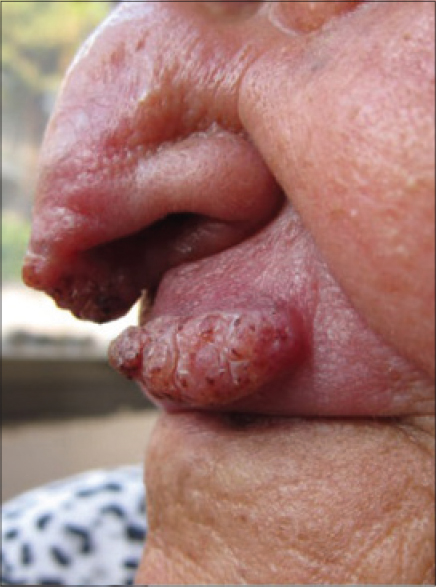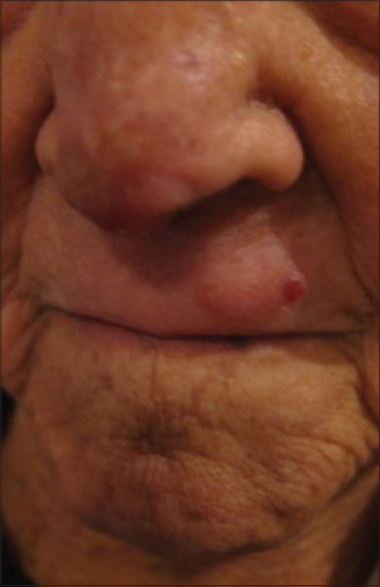Translate this page into:
Cutaneous leishmaniasis mimicking verrucous carcinoma: A case with an unusual clinical course
Correspondence Address:
Andac Salman
Department of Dermatology, Ministry of Health Marmara University Pendik Research and Application Hospital, Fevzi Cakmak Mah, Mimar Sinan Cad, No: 41 Postal Code: 34899 Pendik, Istanbul
Turkey
| How to cite this article: Salman A, Yucelten AD, Seckin D, Ergun T, Demircay Z. Cutaneous leishmaniasis mimicking verrucous carcinoma: A case with an unusual clinical course. Indian J Dermatol Venereol Leprol 2015;81:392-394 |
Sir,
An 86-year-old Turkish woman from the southeastern Anatolia region presented with an erythematous and crusted plaque on her upper lip and nose for six months, which was not responding to treatment with topical corticosteroids and systemic antibiotics. She had hypertension and was on treatment with hydrochlorothiazide and losartan potassium, and suffered from anemia as well. She had cutaneous leishmaniasis over the nose when she was 3 years old.
Cutaneous examination revealed an erythematous and indurated plaque with erosions extending from the upper lip to the tip of nose. There was no mucosal involvement or regional lymphadenopathy. Tzanck smear examination revealed intracellular and extracellular Leishman-Donovan bodies. Histopathological examination of the lesion also revealed numerous Leishman-Donovan bodies in the cytoplasm of histiocytes thus confirming the diagnosis of cutaneous leishmaniasis.
The patient was started on a treatment schedule that comprised of oral itraconazole 200 mg/day along with a weekly dose of intralesional meglumine antimonate (1.5 g/5 ml). However, the treatment was stopped by the fourth week due to lack of clinical response and intolerance to the pain of injection. Liposomal amphotericin B infusion (3 mg/kg per infusion) was then given for five consecutive days, followed by a sixth dose on day 10. This resulted in a slight clinical improvement but the patient was then lost to follow up.
Four months later, she presented with a large and rapidly growing, verrucous and hyperkeratotic mass, firm in consistency on her nose and upper lip [Figure - 1]. Although there was a clinical suspicion of verrucous carcinoma, a repeat histopathological study revealed pseudoepitheliomatous hyperplasia and multiple Leishman-Donovan bodies in the section, consistent with leishmaniasis.
 |
| Figure 1: Verrucous lesions before treatment with topical ketoconazole and povidone iodine |
In view of the risk of cardiotoxicity with systemic pentavalent antimonials, we planned treatment with oral miltefosine. As this medicine was not immediately available, the patient′s son used to cleanse the lesions with povidone iodine 10% solution and apply ketoconazole 2% cream once daily. A dramatic and unexpected clinical improvement was observed at the end of one month so we decided to continue the same treatment. The lesions almost completely resolved at the end of six months [Figure - 2] and [Figure - 3].
 |
| Figure 2: Clinical improvement with topical therapy at the end of one month |
 |
| Figure 3: Near complete resolution of the lesions after six months of topical treatment |
Leishmaniasis is a protozoal disease caused by Leishmania species and transmitted to humans via sandflies. [1] The disease is divided into three major clinical forms: cutaneous, muco-cutaneous, and visceral leishmaniasis. In acute cutaneous leishmaniasis, spontaneous healing is seen in 80-90% of cases during the first 2 years. The remaining 5-10% progress into chronic cutaneous leishmaniasis. [1],[2] Depending upon the host immunity, recurrence is seen in 2-5% of patients. This recurrent form is called leishmaniasis recidivans, which may be the case in our patient. Although most of the lesions heal spontaneously, treatment is needed to reduce scarring and prevent dissemination. Medical intervention is also required in large, multiple, disfiguring, chronic or progressive lesions, mucosal involvement and immunosuppression. Multiple treatment options are available, with varying efficacy. [1],[2],[3]
The interesting aspects about our case were the striking similarity to verrucous carcinoma and the unexpected response to topical ketoconazole and povidone iodine, despite the resistance to systemic itraconazole and amphotericin B. A late onset effect of systemic treatment could have played a role. However, the rapid progression of lesions after an initial phase of mild improvement makes this hypothesis unlikely. Clinical response to the liposomal amphotericin B is usually expected within two months. [4] The regression of lesions may most likely be due to the therapeutic effect of topical ketoconazole and povidone iodine. However, a randomized controlled trial showed no significant difference between topical ketoconazole and placebo. [5] An improvement in the immune status of the patient may contribute to clinical remission. [1],[2] Our patient was 86 years old, so improvement of immune status without any intervention is unlikely.
Although it is not possible to arrive at a definite conclusion from a single case report, it would be interesting to study the effects of topical medications such as ketoconazole cream and povidone iodine solution on leishmaniasis in future studies.
| 1. |
David CV, Craft N. Cutaneous and mucocutaneous leishmaniasis. Dermatol Ther 2009;22:491-502.
[Google Scholar]
|
| 2. |
Douba MD, Abbas O, Wali A, Nassany J, Aouf A, Tibbi MS, et al. Chronic cutaneous leishmaniasis, a great mimicker with various clinical presentations: 12 years experience from Aleppo. J Eur Acad Dermatol Venereol 2012;26:1224-9.
[Google Scholar]
|
| 3. |
Sundar S, Chakravarty J. Leishmaniasis: An update of current pharmacotherapy. Expert Opin Pharmacother 2013;14:53-63.
[Google Scholar]
|
| 4. |
Solomon M, Pavlotsky F, Leshem E, Ephros M, Trau H, Schwartz E. Liposomal amphotericin B treatment of cutaneous leishmaniasis due to leishmania tropica. J Eur Acad Dermatol Venereol 2011;25:973-7.
[Google Scholar]
|
| 5. |
Momeni AZ, Aminjavaheri MM, Omidghaemi MR. Treatment of cutaneous leishmaniasis with ketoconazole cream. J Dermatolog Treat 2003;14:26-9.
[Google Scholar]
|
Fulltext Views
3,139
PDF downloads
3,547





